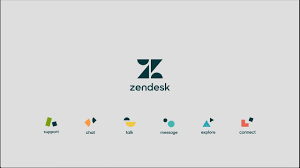Zendesk | Support Suite
The Zendesk help desk tool is now called Zendesk for Service.
The new name represents a change in focus on combining different products into a single offering called “the Service.”
This will make the Service better at things like message channels, workflow management, and more.
As a result of the change, Zendesk’s prices have gone up, and the program is still hard to customize in some ways.
Even though Zendesk lacks some features that other customer-facing Editors’ Choice winners like Freshdesk and HappyFox have, it is still a good tool to think about.
This has changed the name of its goods to Zendesk for Service and made them work better.
Since the last time, we looked at the Zendesk Marketplace, over 1,200 new third-party apps and connections have been added.
These may add to your costs, but they also make it easy for businesses to deal with problems that are common in certain fields or with certain needs.
The agent’s office has been changed to make it easier to keep track of conversations that are happening on different channels.
Knowledge management and communication have also been made better.
Also, Zendesk has been updated with new tools for “rich conversations.”
This means giving customers as many ways as possible to give feedback and using internal dashboards and integrations with third-party analytics tools to find meaning and insights from those interactions.
Zendesk Description

The prices for Zendesk for Service have changed.
The Team plan now starts at $49 per person per month. This is the first group, and it gives SMBs only the most basic features.
The next step up, called the “growth tier,” costs $79 per agent per month and adds features like light agents, self-service, and automation.
The next level up is the $99 Professional plan, which has more features like collaborative tools, advanced routing rules, and in-app data.
At the very top of the stack are three Enterprise layers.
These start at $150 per agent per month and include things like a larger set of APIs for internal customization, support for up to 1,000 “light” licenses (users who don’t need full agent rights to access the system), and fine-grained control over things like agent environments and branding.
Zendesk for Service helps service workers, but it can also help other systems, like your company’s customer relationship management (CRM), because it’s easy to export important data to apps like these.
Zendesk’s Zendesk Sell CRM system is the easiest to use, but the company also lets third-party apps join through its large app marketplace.
All tickets from all sources end up in the same place, where agents can easily look at them.
Side Conversations let agents talk to other support team members without having to leave the ticket screen.
With this app, it’s easy to send an email or post to Slack from a Zendesk for Service office.
Voice over IP (VoIP) allows agents to quickly switch between chat, email, and the company’s phone.
Users of Zendesk can send problems to support through a number of channels, such as Facebook and Twitter.

Popular instant chat apps like WhatsApp and Messenger are the same.
You can still use channels like email, phone help (through integration), and a self-service portal that is built in. Also, Apple Business Chat and Slack have added the ability to send and receive business messages to macOS and iOS, respectively.
At the time of writing, nobody knew anything about Microsoft Teams being added.
The reporting and data tool Zendesk Explore is now part of all premium plans.
Explore has dashboards for the most popular types of data already. Users in the enterprise can make their own versions of these screens and change anything they want.
You can share data from your dashboard in more than just Excel and CSV. You can also do it as images and PDF files.
Images can be resized in the export form to fit a variety of devices. Export works, but for the price of Zendesk, we had hoped for a little more.
This dataset has all the information about tickets, SLAs, state changes, and backlogs from the past.
Agents are given a dashboard that is already set up with a set of pre-made questions that can be changed to fit their own needs.
You can also start over and make a whole new question. Even though there are other choices, Zendesk has the most features and is the easiest to use, as long as you don’t need to access your info from anywhere else.
Zendesk has made its original help desk platform much more powerful by combining several of its products under one name and improving some of its most important features.
Because of this, the platform has a lot of tools, but it costs a lot more.
Zendesk Review By Online Product Report


Zendesk for Service’s new features includes better multi-channel ticket management, a streamlined app marketplace, and a customized setting for agents and managers. But you should put money aside for it.
Related Articles –

